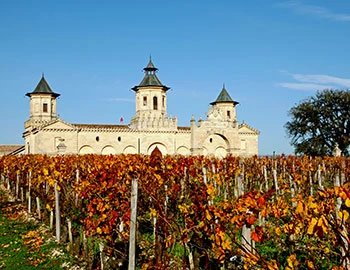
Château Calon-Ségur 2019
AC Saint-Estèphe 3ème Cru classé, 1500 ml

| Grape variety: | Cabernet Sauvignon, Merlot, Cabernet Franc |
| Producer: | Château Calon-Ségur |
| Origin: | France / Bordeaux / St-Estèphe |
| Other bottle sizes: | |
| Other vintages: |
Description
Robert Parker, The Wine Advocate (William Kelley) writes about the vintage 2019: "Vincent Millet (who can boast a doctorate in wine microbiology and who took up his post as Calon's technical director after a stint at Château Margaux) is doing everything right in terms of restructuring the estate's somewhat neglected vineyards with massal selections, higher density plantings, cover crops and precision viticulture. He's also cleaned up and modernized the winery. The 2019 Calon-Ségur shows the impact of some of those changes already, offering up a rich bouquet of crème de cassis, licorice, warm spices and subtle hints of cigar box, followed by a full-bodied, broad and fleshy palate that's deep and concentrated, with lively acids and beautifully refined tannins. All this is very impressive, but the fly in the ointment is an alcohol level that flirts with 15% and makes itself felt on the warm, liqueured finish. Balance isn't a matter of mere numbers, of course, but despite its admirable qualities and the serious work behind it, I do have reservations about this wine's ultimate equilibrium. Time will tell. The good news is that Millet is actively exploring viticultural strategies to mitigate high alcohol levels."
Attributes
| Origin: | France / Bordeaux / St-Estèphe |
| Grape variety: | Cabernet Sauvignon, Merlot, Cabernet Franc |
| Ripening potential: | 8 to 30 years |
| Drinking temperature: | 16 to 18 °C |
| Food Pairing: | Wild specialities, Châteaubriand, Filet Wellington |
| Volume: | 13.5 % |
| Note: | Contains sulphites |
Cabernet Franc
Forefather of the Bordeaux varieties
The Cabernet Franc is one of the oldest varieties of Bordelais and a parent of three other red grapes in the Bordeaux assortment: Cabernet Sauvignon, Merlot and Carmenère. It is distinguished by its complex, flavourful bouquet of raspberry, graphite, violet, liquorice and white pepper. In addition, it presents round, crisp tannins which turn out less strongly than those of Cabernet Sauvignon. While the Cabernet Franc always appears as part of a blend in Bordeaux, it is pressed alone on the Loire. The most renowned appellations are Chinon and Bourgueil. Incidentally, the Cabernet originates not in Bordeaux but in the Spanish Basque Country. Cabernet owes its name to the Latin “carbon”, meaning black.

Merlot
Everybody’s darling
Merlot is the most charming member of the Bordeaux family. It shines with rich colour, fragrant fullness, velvety tannins and sweet, plummy fruit. It even makes itself easy for the vintner, as it matures without issue in cool years as well. This is in contrast to the stricter Cabernet Sauvignon, which it complements as a blending partner. Its good qualities have made the Merlot famous worldwide. At over 100,000 hectares, it is the most-planted grape in France. It also covers large areas in California, Italy, Australia and recently in Eastern Europe. The only catch is that pure Merlot varieties rarely turn out well. Its charm is often associated with a lack of substance. Only the best specimens improve with maturity. They then develop complex notes of leather and truffles. This succeeds in the top wines from the Bordeaux appellation of Pomerol and those from Ticino, among others.

St-Estèphe
Saint-Estèphe: classic, full of vim and vigor
Thanks to their prominent acidity and robust tannins, the wines of Saint-Estèphe are considered absolute classics of the Médoc. The distinct profile of these wines is owed to the particular terroir. Saint-Estèphe borders Pauillac, and is the northernmost of the four famous communal appellations of the Médoc. At the appellation’s best-known châteaux, Cabernet Sauvignon is the leading variety, but there are also producers here whose assemblages incorporate Merlot for the starring role.

Bordeaux
Bordeaux: high prestige, high quality
With a total area of around 115,000 hectares, Bordeaux may not be France’s largest wine-growing region, but it is certainly its most prestigious. The range of wines produced here today is enormous: ranging from red everyday wines with a great relationship between price and quality to exclusive, and accordingly expensive, premier crus. Elegant white wines and noble sweet specialties round out the spectrum.

France
France – Philosophy in a bottle
According to French philosophy, wine should be an expression of the soil and climate. They use the word “terroir” to describe this. Terroir makes every wine different, and many especially good. French wine is regarded worldwide as an expression of cultural perfection. The French believe that humans are responsible for the quality of the berries, the vine variety for their character, and nature for the quantity. This philosophy can be expressed succinctly as: “the truth is the vineyard, not the man.”


